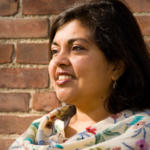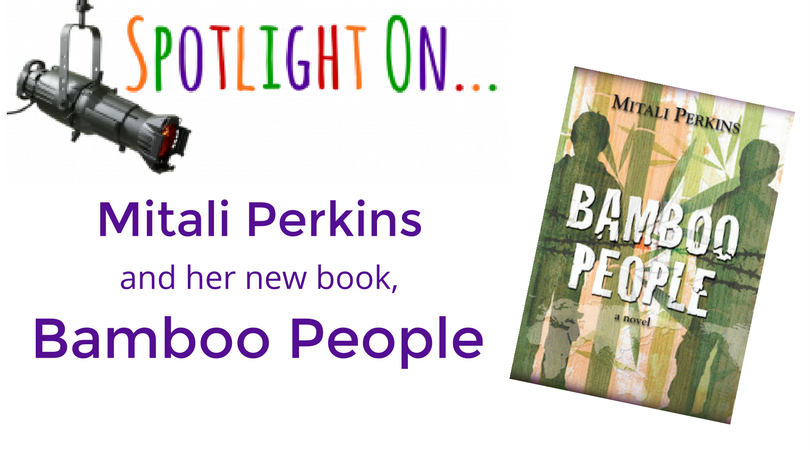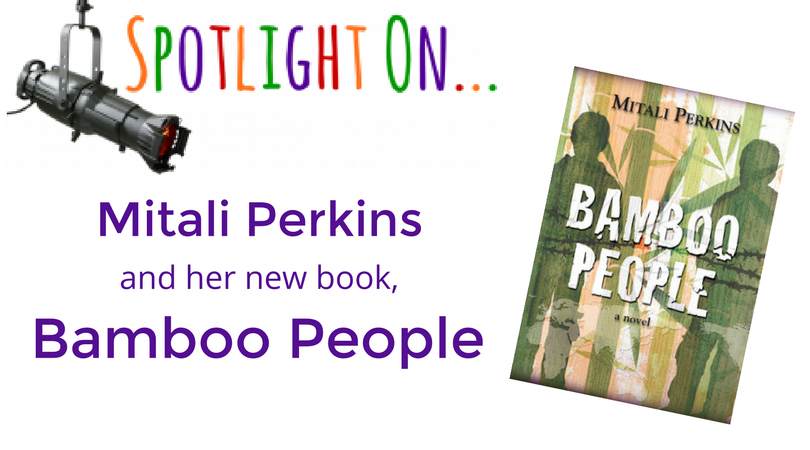
The author spotlighted in this Ink Splat is Mitali Perkins.
Writing Challenge
You see your neighborhood every day. It’s easy to stop noticing the warm yeast of fresh baking bread, or powdery steam from dryer vents. We forget to see the carpet of purple flowers beneath the oak tree, or to hear the hiss of wind through the palm tree branches.
Take a walk outside, and pay attention with all five of your senses. Write a 300-500 word description that spotlights your community: the sights, smells, tastes, sounds and sensations.
Submit your responses by emailing submit@younginklings.org and you might be published on our website! We’d love to give our Inklings community glimpses into the many neighborhoods that we, collectively, call home.
An Interview with author Mitali Perkins
How long have you been writing? When did you realize you wanted to be an author?
I’ve been writing since I can remember, scribbling poems and prayers in notebooks and on scraps of paper. I realized I wanted to be an author after my second novel, Monsoon Summer, was rejected 22 times. When it finally was published – 11 years after my first book (The Sunita Experiment) – I decided to put a shingle out and get busy as “Mitali Perkins, Author.” I’d sweated and worked hard enough to achieve publication and now it was time to honor my vocation.
Once you decided to write Bamboo People, how did you start the process?
We were living in Thailand and visiting refugee camps along the Thai-Burma border. I listened to many stories about young people involved in the war. I wrote a picture book set there first, but editors wanted me to lengthen it, so I wrote Tu-Reh’s half first. As I read what I wrote, it felt like an incomplete, one-sided view of the conflict, so I decided to write Chiko’s story. I interspersed their chapters and then separated them into two stories, wrote them both in real time and then moved Tu-Reh’s part forward in time, wrote it in present tense and then in past, in third person and then in first – it was rejected, and rejected, and rejected until finally Charlesbridge published it.
You write about characters with a wide range of life experiences. How did you get to know Chiko and Tu Reh? Was it difficult to step into the shoes of characters from opposites sides of a conflict?
Chiko’s struggle with courage is mine, so he was easier to write. I’m a scaredy-cat and a nerd. Tu Reh’s bitterness and anger is more the story of my grandfather, who lost his ancestral land and had to flee his village. He never forgave and died a bitter man. I tried to imagine what it might have been like if he had met one of his “enemies” as a young man and had the chance to befriend him.
How much of your description comes from your travel experiences, and how much comes from research? Do you have any tips for us about detailing a setting?
We lived in Northern Thailand for three years, but I also did a lot of research. For me, it’s very difficult to write a novel unless I have lived in a place with all five senses engaged. That would be my primary tip – to learn how to dwell deeply in a particular place, smelling, seeing, hearing, tasting, and touching.
What’s your favorite thing about writing? Least favorite?
My favorite thing is that I’m my own boss. I work when and how I want to, and that’s a good thing. My least favorite thing is that I’m my own boss. I have to motivate myself to write. There is nobody else to push me or give me incentive to GET IT WRITTEN. And that’s hard.
What is the most difficult part of your creative process?
The first draft is hardest. Finishing it will practically kill me creatively. And it is usually terrible. But once I am done, I have confidence in my ability to revise, probably stemming from all of the rejections I’ve received in the past.
If you could tell your younger writing self something, what would it be?
You are going to get to do what you love to do for your life’s vocation; blessed are you, dear one.
And one last question for you: we send out our Ink Splat to our full community, which ranges from 1st grade writers up through high school. Can you guide us about which of your books are appropriate for which age groups?
My books Tiger Boy and Rickshaw Girl are also set in faraway places, and are easier for younger readers. Rickshaw Girl is going to be released as a film in 2018, so that might be a fun novel to share with your 1st-4th grade reader. Bamboo People is recommended for fifth-grade and higher.
A special thanks to Mitali Perkins!
 Mitali Perkins (mitaliperkins.com) has written ten novels for young readers, including Rickshaw Girl (chosen by the New York Public Library as one of the top 100 books for children in the past 100 years), Bamboo People (an American Library Association’s Top Ten Novels for Young Adults), and Tiger Boy, which won the NCTE Charlotte Huck Honor Award and the South Asia Book Award. Her newest is a young adult novel called You Bring the Distant Near, releasing 9/12/17. She has been honored as a “Most Engaging Author” by independent booksellers and selected as a “Literary Light for Children” by the Associates of the Boston Public Library. Mitali was born in Kolkata, India before immigrating to the United States with her family. She has lived in Bangladesh, India, England, Thailand, Mexico, Cameroon, and Ghana, studied at Stanford and U.C. Berkeley, and currently resides in the San Francisco Bay Area.
Mitali Perkins (mitaliperkins.com) has written ten novels for young readers, including Rickshaw Girl (chosen by the New York Public Library as one of the top 100 books for children in the past 100 years), Bamboo People (an American Library Association’s Top Ten Novels for Young Adults), and Tiger Boy, which won the NCTE Charlotte Huck Honor Award and the South Asia Book Award. Her newest is a young adult novel called You Bring the Distant Near, releasing 9/12/17. She has been honored as a “Most Engaging Author” by independent booksellers and selected as a “Literary Light for Children” by the Associates of the Boston Public Library. Mitali was born in Kolkata, India before immigrating to the United States with her family. She has lived in Bangladesh, India, England, Thailand, Mexico, Cameroon, and Ghana, studied at Stanford and U.C. Berkeley, and currently resides in the San Francisco Bay Area.
Find your local independent book store to purchase Bamboo People, it is also available at most other nationwide bookstores or online.



